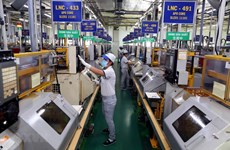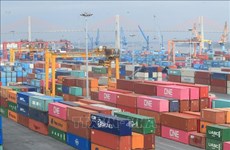Exports in 2022 breakthrough to record levels
 In the first quarter of 2022, Vietnam has 16 export items exceeding 1 billion USD. (Photo: VNA)
In the first quarter of 2022, Vietnam has 16 export items exceeding 1 billion USD. (Photo: VNA)Despite many challenges, especially the unprecedented COVID-19 pandemic, Vietnam's export turnover in the first quarter of 2022 still attained unprecedented levels and a record-high growth rate.
In the first quarter of 2022, the country had 16 items with export turnover of over 1 billion USD, accounting for 83.4% of total export turnover. These numbers brought with them a trade surplus of about 809 million USD each.
Those figures showed production and business activities continue to recover strongly, contributing to the overall growth of the economy.
In an interview granted to VNA reporters, Tran Thanh Hai, Deputy Director of the Agency of Foreign Trade under the Ministry of Industry and Trade said that despite many positive results, there are still challenges in the coming months of the year, and Vietnam can utilize it.
FTA – Boosting exports
- With results achieved in the first quarter of the year, what are opportunities for Vietnam's exports in the coming time?
Tran Thanh Hai: It can be said that the biggest opportunities are free trade agreements (FTAs). In recent times, Vietnam has signed large trade deals with strong commitments.
Particularly the CPTPP, EVFTA, UKVFTA, RCEP agreements are all with big trade partners and those deals have brought about very significant effects.
For example, in the CPTPP agreement, with new countries joining a free trade agreement with Vietnam such as Mexico, Peru, etc., the growth rate in Vietnam's exports has increased 25-35%. The figure clearly represents an opportunity for Vietnamese businesses.
In the upcoming RCEP agreement, with a stronger commitment mechanism, Vietnamese businesses will have greater opportunities for exports to ASEAN countries and 5 ASEAN partners
Moreover, countries such as China, Republic of Korea, Japan, and others have also joined the RCEP. They supply raw materials to Vietnam. Therefore, the RCEP will create rotation and help Vietnam better connect the input and output supply chain.
- There are advantages, but certainly challenges. Can you name the biggest challenges that Vietnamese businesses may face in the near future?
Tran Thanh Hai: The biggest difficulty in the immediate future is still the impact of the COVID-19 epidemic. Although the pandemic has been put under control in Vietnam and the country has taken safe measures to restore production, the impact of COVID-19 in other markets can still affect us.
In particular, the epidemic is still increasing in China and with the Zero COVID-19 policy, China could still lockdown a city or a production center. It used to happen in the past time.
Thus, if an area that is supplying raw materials in large quantities to Vietnam is affected by the lockdown, it will obviously affect the supply of raw materials.
In addition, transportation and logistics problems in the past two years caused by the impact of the epidemic have increased sea freight rates and so far there have been no signs of cooling. The epidemic situation in China is still complicated, causing congestion in many seaports and a hike in freight rates.
In the context of tension between Russia and Ukraine, although Vietnam's trade relationship with the two countries is not large, these two countries are suppliers of raw materials to Vietnam like wheat, coal, and fertilizer. Thus the conflict affects prices on the global market, leading to an increase in input prices of raw materials for many countries, including Vietnam./.












